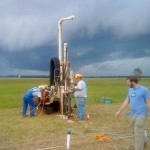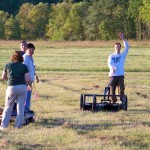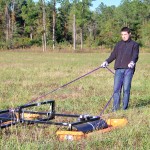 ]]>
]]>



We would like to thank the National Science Foundation for funding this research.
]]> We are using electrical resistivity tomography to image the dynamic nature of soil moisture, and coupling this with high resolution models to better understand transpiration dynamics and unsaturated flow. We are using time-lapse hydrogeophysical tools to characterize soil moisture variability beneath a range of vegetation types. Those tools include 2D and 3D electrical resistivity tomography (ERT), and ground-penetrating radar (GPR).
We are using electrical resistivity tomography to image the dynamic nature of soil moisture, and coupling this with high resolution models to better understand transpiration dynamics and unsaturated flow. We are using time-lapse hydrogeophysical tools to characterize soil moisture variability beneath a range of vegetation types. Those tools include 2D and 3D electrical resistivity tomography (ERT), and ground-penetrating radar (GPR).
We will then combine our measurements with detailed site characterization, point measurements of soil temperature and moisture, and numerical models of hydrological and plant processes to quantify root-zone moisture dynamics with an unprecedented level of detail.
Related Publications:
Related Conference Abstracts:
- Jayawickreme, DH, MA Malkowski, RL Van Dam, and DW Hyndman, (2007), Characterizing Long-Term Near-Surface Soil Moisture Variability in Natural Environments using Electrical Resistivity Imaging and Hydrological Modeling, Eos Trans AGU, 88 (52), Fall Meet Suppl, Abstract H11G-02
- Van Dam RL, DH Jayawickreme, and DW Hyndman, (2007), Vadose Zone Resistivity Variations Across a Michigan Ecotone, Geological Society of America, Abstracts with Programs
- Jayawickreme, DH, RL Van Dam, DW Hyndman, (2006), Transient Soil Moisture Characteristics Below Different Land Cover Types: Implications for Quantifying Groundwater Recharge, H13B-1387, Eos Trans AGU